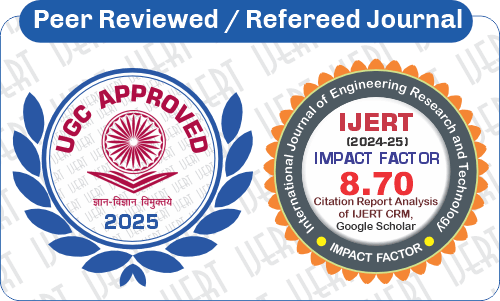 DOI : 10.17577/IJERTV4IS020399
DOI : 10.17577/IJERTV4IS020399
- Open Access

- Total Downloads : 94
- Authors : Shribai Meena, Shiv Ram Saini, Dr. R. C. Meena
- Paper ID : IJERTV4IS020399
- Volume & Issue : Volume 04, Issue 02 (February 2015)
- Published (First Online): 27-02-2015
- ISSN (Online) : 2278-0181
- Publisher Name : IJERT
- License:
 This work is licensed under a Creative Commons Attribution 4.0 International License
This work is licensed under a Creative Commons Attribution 4.0 International License
Study of Photosensitizer (Phloxine B) for Conversion of Solar Energy in to Electrical Energy
Shribai Meena*, Shiv Ram Saini and Dr. R.C. Meena Department of Chemistry JNV University Jodhpur, Rajasthan (INDIA)-342005
Abstract – The Photo voltages and Photocurrents in photo galvanic cell containing Phloxine B as a photo sensitizer with EDTA as reductant for the enhancement of the conversion efficiency and storage capacity of photo galvanic cell for its commercial viability. The observed value of the photo generation of photo potential was 910.0mV and photocurrent was 250.0 µA. The observed power at power point was 135.30
µW and the conversion efficiency was 1.3009. The fill factor 0.4685 was observed experimentally observed at the power of the cell. The photo galvanic cell that developed can work for 120 min in dark. The storage capacity of the cell is 54%. The effect of different parameters on electrical output of the cell was observed. A mechanism has also been proposed for the generation of the photocurrent and photo potential in photo galvanic cell.
Key Words: Phloxine B, Storage capacity, EDTA and Conversion efficiency.
INTRODUCTION:
Solar energy is accepted as a key resource for the future of the word. Energy is the soul of life. The utilization of solar energy could cover a significant part of the energy demand in the countries. Solar energy is one of the best renewable energy sources with least negative impacts on the environment. The photo effects in electrochemical systems were first reported by Becquerel [1,2]. In his investigation on the solar illumination of metal electrodes long back. Suda et al.[3]. And A.K.Jana reported enhancement in the power output of a solar cell consisting of mixed dye [4]. Studies the performance of dye sensitized solar cells based on nanocrystals TiO2 films prepared with mixed template method by Gratzel and Regan [5] Optimum efficiency of photogalvanic cell for solar energy conversion has been studied by Albery and Archer [6].
Some researchers [7-8] have studied on how to enhance the performance and optimum efficiency of dye sensitized solar cell for solar energy conversion. Ameta et al.[9] reported use of toluidine blue nitroloacetic acid (TB-NTA) system in photo galvanic cell for solar energy conversion. They also reported the use of micelles in photo galvanic cell for solar energy conversion and storage in Azur A- Glucose system,. Gangotri et al studied the photo galvanic
effect in mixed reductants system for solar energy conversion and storage.[10]-[12]. Photo galvanic cells containing reductants, surfactants and photosensitizers were reported by Meena et al. [13]-[18]. This paper focuses on the e photochemical study of photo galvanic cell for enhancing their efficiency. Which is containing Phloxine B- EDTA system?
EXPERIMENTAL:
Phloxine B (MERCK), EDTA (MERCK) and NaOH (MERCK) were used in the present work. The stock solutions of all chemicals were prepared by direct weighing, in doubly distilled water and were kept in colored container to protect them from light. The system was systematically set for photo galvanic studies, which consists of electrochemically treated platinum as electrode and saturated calomel electrodes as a reference electrode. The distance between the illuminated and dark electrode is
45 mm. A tungsten lamp of 200 W was used as light source. Water filter was used to cut-off IR radiations. The photo potential was obtained as the difference between the initial potential of the system in dark and the equilibrium potential attained by the system under constant illumination. First of the potential measured in dark and the change in potential on illumination was measured as a function of time. Solutions of dye, reductant, and sodium hydroxide were taken in an H-type glass tube. A platinum electrode (1.0 x 1.0 cm2) was immersed into one arm of H- tube and a saturated calomel electrode (SCE) was kept in the other. The whole system was first placed in dark till a stable potential was obtained and then, the arm containing the SCE was kept in the dark and the platinum electrode was exposed to a 200 W tungsten lamp. A water-filter was used to cut off infrared radiations. A digital pH meter (Systronics Model-111) and a microammeter (Ruttonsha Simpson) were used to measure the potential and current generated by the system, respectively. The experimental
set-up of photogalvanic cell is given in Figure 1. The effect of variation of different parameters has also been observed.
900
photopotential photocurrent power
280
Photocurrent(µA) & Power(µA)
260
Photopotential (mV)
820
740
660
580
500
0.1 0.4 0.7 1 1.3 1.6 1.9
Phloxin B ×10-5 M
Fig.-2: Effect of variation of Phloxine B concentration
240
220
200
180
160
Figure: 1 experimental set up of photogalvanic cell
RESULT AND DICUSSION
Effect of Variation of Dye ( Phloxine B) Concentration On the Cell:
It is founed that when concentration of dye increased, the photopotential and photocurrent were increased with it. A maximum was obtained for a particular value of Phloxine B concentrations, above which a decrease in the electrical output of the cell was obtained. The reason of the change in electrical output is that lower concentration of photosensitizer resulted into a fall inelectrical output because fewer photosensitizer (Phloxine B) molecules are available for theexcitation and consecutive donation of the electrons to the platinum electrode whereas the higherconcentration of photosensitizer (Phloxine B) again resulted into a decrease into electrical outputas the intensity
Effect Of Variation Of Reductant Concentration On The Cell:
Effect of variation of reductant concentration is that the photopotential and photocurrent were found to increase with the increase in concentration of the reductant [EDTA], till it reaches a maximum. On further increase in concentration of EDTA, a decrease in the electrical output of the cell was observed. The reason of the change in electrical output is that the lower concentration of reducing agent resulted into a fall in electrical output because fewer reducing agent molecules are available for electron donation photosensitizer (Phloxine B) molecule whereas the higher concentration of reducing agent again resulted into a decrease in electrical output, because the large number of reducing agent molecules hinders the dye molecules from reaching the electrode in the desired time limit. The results are given in Figure 3
of light reaching the dye molecules near the electrode
decrease due to absorption ofthe major portion of the light by dye molecules present in the path. The results are given in Figure 2.
920
Photopotential (mV)
860
800
740
Photopotential photocurrent power
320
Photocurrent(µA) & Power(µW)
280
240
680 200
620
560
160
500
1.32 1.37 1.42 1.47 1.52
EDTA × 10-3 M
120
Fig.-3:Effect of variation of Reductant concentration
Effect of Variation of Ph on the Cell:
The effect of variation in pH on photoelectric parameters of cell is observed and found that the cell containing Phloxine B -EDTA to be quite sensitive to the pH of the solution. It is observed that there is an increase in the photoelectric parameters of this cell with the pH value (In the alkaline range). At pH 11.8 a maxima is obtained. On further increase in pH, there is a decrease in photoelectric parameters. It is observed that the pH for the optimum condition has a relation with pKa of the reductant and the desired pH is higher than in pKa value (pH>pKa). The reason of the change in electrical output is that the availability of the reductant in its anionic form, which is a better donor form. The above same is reported in graph 3.
Photopotential
260
Photocurrent(µA)
220
180
140
100
maximum photocurrent eq. photocurrent
rate of initial gen. photocurrent
58
56
Rate (µAmin-1)
54
52
50
48
46
44
42
30 35 40 45 50 55 60
Diffusion length (mm)
photocurrent
880
power
800
Photopotential (mV)
720
640
560
480
400
10.2 11.2 12.2
pH
280
Photocurrent(µA) & Power(µA)
250
220
190
160
130
100
275
Max. Photocurrent(µA)
240
205
170
135
Fig.-4: Effect of Diffusion length
max.Photocurrent eq.photocurrent
300
Eq, Photocurrent(µA)
275
250
225
200
175
Fig.- 3: Effect of Variation of pH
Effect of Diffusion Length and Electrode Area on the Cell:
100
0 0.5 1 1.5 2
Electrod area cm2
Fig.5: Effect of Electrode Area
150
The effect of variation in diffusion length (distance between the two electrodes i.e. SCE and Pt electrode) on the photoelectric parameters of the cell (Imax, ieq and initial rate of generation of photocurrent) is studied using H-shaped cells of different dimensions. It is observed that both imax and rate of change in initial generation of photocurrent (A min-1) increase with respect to the diffusion length whenever the equilibrium photocurrent (ieq) shows a small decrease with respect to the diffusion length. The effect of electrode area on the photoelectric parameters of the cell is also reported here. The rate of change in photoelectric parameters with respect to the diffusion length is presented in Figure 4.Similarly, Figure 5 shows rate of change in photoelectric parameter with respect to electrode area.
Effect Of Temperature And Light Intensity On The Cell: The effect of temperature and light intensity on the photoelectric parameters of the cell is studied. It is observed that the photocurrent of the photo galvanic cell is found to be increased with the temperature whereas the photo potential is decreased. The reason of the change in electrical output is that internal resistant of the cell decreases at higher temperature resulting into a rise in photocurrent and correspondingly, there will be a fall in photo potential. The observation is presented in Figure 6. Similarly, Figure 7, shows rate of change in photoelectric parameter with respect to light intensity. The light intensity is measured in terms of mWcm-2 with the help of solarimeter (CEL Model SM 111). It is found that the photocurrent show linear increasing fashion with light intensity whereas the photo potential show an increment in a logarithmic fashion.
950
900
850
Photopotential (mV)
800
750
700
650
600
550
500
photopotential photocurrent
Photopotential (µA)
290 295 300 305 310 315
Temperature (K)
Fig.- 6: Effect of Temperature
300
270
240
210
180
300
250
Photocurrent (µA)
200
150
100
50
0
Power Point =135.3
0 200 400 600 800 1000
Photopotential (mV)
Fig.-8: Current Voltage (i-V) Curve of the cell
300
Photocurrent(µA)
270
240
210
180
150
photocurrent log V
0 10 20 30
Light intensity (mW cm2)
Fig.-7: Effect of Variation of Light Intensity
3
2.8
2.6
Log V
2.4
2.2
2
A point in i-V curve, called power point (pp) was determined where the product of current and potential was maximum and fill factor was calculated by using the following formula.
Vpp x ipp
Fillfactor ( )= (1) Voc x isc
Storage Capacity and Conversion Efficiency of the Cell:
The storage capacity (performance) of the photogalvanic cell is observed by applying an external load (necessary to have current at power point) after terminating the illumination as soon as the potential reaches a constant value. The storage capacity is determined in terms of t1/2,
Current-Voltage (I-V) Characteristics of the Cell:
The short circuit current (isc) and open circuit voltage (Voc) of the photogalvanic cells are measured with the help of a multimeter (keeping the circuit closed) and with a digital pH meter (keeping the other circuit open), respectively. The current and potential values in between these two extreme values are recorded with the help of a carbon pot (log 470 K) connected in the circuit of Multimeter, through which an external load is applied. The
-
., the time required in the fall of the output (power) to its half at power point in dark. It is observed that the cell can be used in dark for 120 minutes on irradiation for 220 minutes. So the observed storage capacity of the cell is 54
% the results are graphically presented in Figure 9.
140
120
100
current-voltage (i-V) characteristics of the photogalvanic 80
cells containing Phloxine B-EDTA cell is graphically
Power (µW)
shown in Figure 8. 60
40
t1/2 = 120 min.
20
0
0 50 100 150 200
Time (min.)
Fig.- 9: Performance of the Cell
The conversion of the efficiency of the cell is determined as 1.3009 with the help of photocurrent and photo potential values at the power point and the incident power of radiations by using the formula
Vpp x ipp ConversionEfficiency= x100% (2)
10.4 mW
Performance of the Cell
The overall performance of the photogalvanic cell is observed and reached to remarkable level with respect to electrical output, initial generation of photocurrent, conversion efficiency and storage capacity of the photogalvanic cell.
Table-8:- Performance of the cell
s.
no. parameters observed value
1. Dark potential 245.0 mV
2. Open circuit voltage (VOC) 1155.0 mV
3. Photopotential (DV) 910.0 mV
4. Equilibrium photocurrent (I eq) 250.0 mA
5. Maximum photocurrent (I max) 270.0 mA
6. Initial generation of photocurrent 49.15
7. Time of illumination 220.0 min
8. Storage capacity (t1/2) 120.0 min
9. % of storage capacity of cell 54%
10. Conversion efficiency 1.3009 %
11. Fill factor () 0.46
MECHANISM
On the basis of these observations, a mechanism is suggested for the generation of photocurrent in the photogalvanic cell as:
Dye Dye* (3)
Dye* + R Dye- (Semi or leuco) + R (4)
Dye- Dye + e – (5)
Dye + e- Dye (Semi or leuco) (6)
Dye – + R+ Dye + R (7)
Where Dye, Dye*, Dye, R and R+ are the dye, excited form of dye, semi or leuco form of
dye, reductant and oxidized form of the reductant, respectively.
CONCLUSION:
Conclusively the reductant (EDTA) and dye (Phloxine B) can be used successfully in a photogalvanic cell. The conversion efficiency and storage capacity of the cell is 1.3009 and 120 minutes respectively, on irradiation for 220 minutes developed photogalvanic cell. It has been observed that the reductant has not only enhanced the electrical parameters (i.e. photopotential, photocurrent and power) but also enhanced the conversion efficiency and storage capacity of photogalvanic cell. The efforts are also successful because of the phtogalvanic cells showed good prospects of becoming commercially viable.
NOMENCLATURE:
Ieq = photocurrent at equilibrium Imax = maximum photocurrent Ipp = photocurrent at power point Isc = short circuit current
Ml = milliliter mV = millivolt M = molarity
Pp = power point
t1/2 = storage capacity of cell DV = observed photopotential Voc = open circuit voltage
Vpp = photopotential at power point = fill factor
mA = microampere mW = microwatt
ACKNOWLEDGEMENT:
The authors are thankful to the Head Department of Chemistry Jai Narain Vyas University Jodhpur Rajasthan (342005) for providing the necessary laboratory facilities to conduct this research work and also thankful to UGC New Delhi India for providing RGNF for financial support to this research work.
REFERENCES:
-
E. Becquerel, C.R. Acad. Sci. Paris, 9,14, (1839).
-
E. Becquerel, , C.R. Acad. Sci. Paris, ,9,561, (1839a).
-
Y.Suda, Y.Shimoura, T. Sakata and H.Tsubomura, J. Phys. Chem. 82,268-271, (1978).
-
A.K.Jana, J. Photochem. Photobio., 132, 1-17, (2000),
-
M.Gratzel, and B.O.Regan, Nature, 353, 737-740, (1991).
-
W.J.Albery, and M.D.Archer,Nature, 270, 399-402, (1977).
-
S.Madhwani, J.Vardia, P.B.Punjabi. and V.K Sharma. J. Power and Energy: Part A, 221, 33-39, (2007).
-
S.C.Ameta S. Khamesra , A.K.Chittora , and K.M.Gangotri, Int.J. Energy 13(6) 643- 647 (1989).
-
S.C.Ameta, Khamesra, Lodhas. and R..Ameta J. Energy Chem. 48(1), 81-86(1989).
-
K.M.Gangotri, R.C. Meena and Rajni Meena, J. Photochem. Photobio. A. Chem. 123,93, (1999),
-
K.M.Gangotri, R.C. Meena J. Photochem. Photobio. A. Chem., 141, 175-177,(2001).
-
M. Chandra and R.C Meena, Int. J. Chemical Sciences, 8(3), 1447-1456, (2010).
-
M. Chandra and R.C Meena, J. Chem. & Pharm. Research, 3(3), 264-270, (2011),
-
M. Chandra A .Singh, and R.C. Meena, Int. J. Physical Sciences, 7(42), 5642-5647, (2012).
-
A.S.Meena, P.L. Meena, M Chandra, R. Meena, Shribai and R.C. Meena, Int. J. Electrical Engineering & Technology (IJEET), 4(4), 180- 187, (2013).
-
A.S Meena.,Rishikesh, Shribai and R.C. Meena,Int. J. Advanced research in Engineering & Technology(IJARET), 4 (6), 17-26, (2013).
-
A.S Meena.,Rishikesh, Shribai and R.C. Meena, Int. J. of Electrical.Electronicsand Telecommunication Engineering,(IJEETE), 4 (2), (2013).
-




